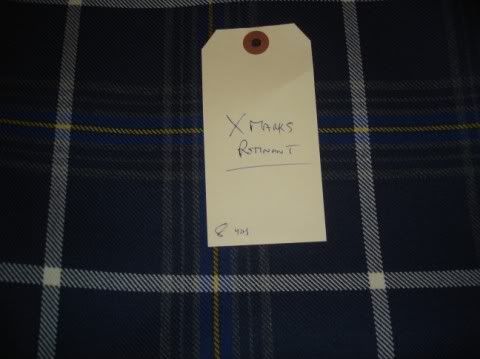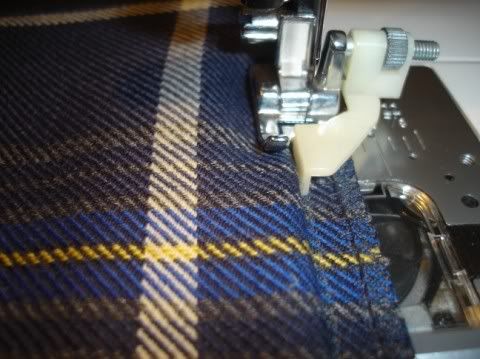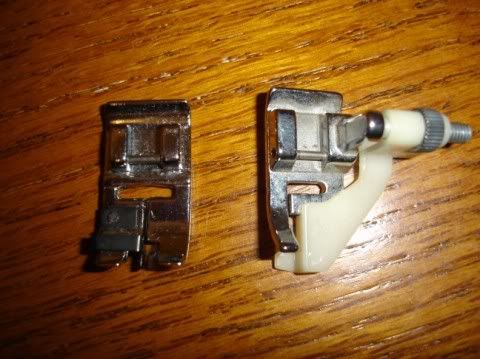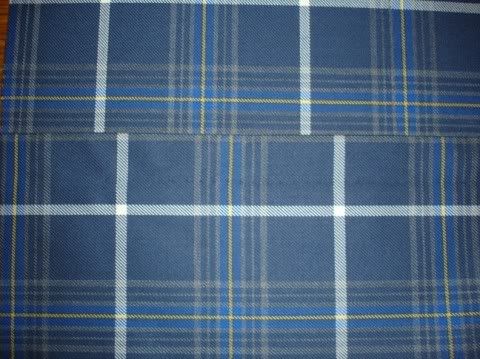|
-
25th October 07, 09:15 PM
#1
Hemming a Kilt, Sewing Accessories that Help
I purchased 8 meters of Xmarks tartan with damaged selvedge. I trimmed off the damaged part and got ready to hem it. After looking at it for a while I remembered I had a blind hem attachment for my machine.
Then I remembered that I had seen a lot of inquiry about hemming kilts. For those that have a machine with a zig zag or blind hem stitch here is a method to quickly make your kilt shorter. I bought this and another attachment at my local sewing machine shop for about twenty bucks.
Start with 8 yards of damaged tartan and trim off the damaged edge. I saved it to use for the waistband on my next kilt (there were only about 4 bites taken out of the selvedge)

The foot in action. I also use this for getting the edge distances consistent on sewn in pleats.

Closeup of the blind hemmer on the right and a quilting foot that I use for other kilt sewing. The spring steel in the center allows you to follow any existing stitch or groove like sewing on a waist band from the outside or setting a little offset to sew down a fell.

Here is 9 yards of hemmed Xmarks. The dimples you see press right out with a little steam to relax where they were sewn. Now and then a stich will peak through or you miss with a few. If you want perfection this method isn't for you. I did it because I'm just making half handsewn kilt for this winter. All hidden seams will be machine sewn. Visible stuff by hand.

-
-
27th October 07, 01:41 AM
#2
I routinely use a Babylock blind hemmer when I do kilts with hems (typically for dancers). I use transparent nylon thread, and it works great. Can't even see the stitches, and it's much faster than stitching by hand.
B
-
-
27th October 07, 06:58 AM
#3
I feel better about doing it now that I know I have good company. I'd never done a blind hem before. I always had my taylor do it for me. I was looking at tackling this selvedge by hand and remembered I had the attachment. After sewing the pleats by hand yesterday the dimples relaxed and are invisible now. If the thread I was using wasn't such a great match I'd have gone with the clear thread.
Last edited by O'Neille; 27th October 07 at 07:09 AM.
-
-
27th October 07, 09:35 AM
#4
Sometimes there is no choice but to use a machine. I must admit I've never thought of using transparent thread. Thanks, Barb
Past President, St. Andrew's Society of the Inland Northwest
Member, Royal Scottish Country Dance Society
Founding Member, Celtic Music Spokane
Member, Royal Photographic Society
-
-
28th October 07, 04:59 AM
#5
I use a sewing machine in only three places on a kilt, and I think all three are perfectly legitimate. If a kilt needs a hem, I can't see any reason not to use a blind hemmer. If the bottom edge of the lining apron/underapron needs to be hemmed because it has a raw edge, I'm perfectly happy to do that little hem on the machine. And, if I'm home, I'll sew the main seam of the top band by machine to save time. If I'm away, I'll do it by hand. There really isn't much of anywhere else in a kilt that you can use a machine to do a proper job, though.
Cheers,
Barb
-
-
28th October 07, 09:51 AM
#6
I'll most definitely be picking up one of those blind hemmers if/when I get my new sewing machine (Please, Santa, please!).
Thanks for the post, O'Neille!
-
-
28th October 07, 10:59 AM
#7
I've made many a kilt using a sewing machine. I just finished putting the canvas and wasit band on my Xmarks kilt. It was made following the Art of Kiltmaking directions . I only used my sewing machine to sew the waistband and hem the damaged selvedge. I started it Friday night and it is done except the buckles and lining. Although it took longer than machine sewing a kilt It took no time at all to remove an errant stitch and correct a problem. It also makes the first edition much easier to understand when you have had your hands on one that much. I'm going to go put the straps on so I can finish the lining. Then I'll do the buckles, sporran loops and flashes.
I feel comfortable with the sewing now, so I'm going to start another in St. Patricks this week at work. I'd like to see how much I can get done.
The big difference I noticed between machine and hand sewing is that hand sewing is much more relaxing. Especiallly if you make a mistake.
-
-
28th October 07, 11:07 AM
#8
 Originally Posted by O'Neille

The big difference I noticed between machine and hand sewing is that hand sewing is much more relaxing. Especiallly if you make a mistake.
I couldn't agree more. It takes me less time to sew up a sporran than to assemble and prepare it for sewing, but it's the hand sewing I find most relaxing and meditative.
Convener, Georgia Chapter, House of Gordon (Boss H.O.G.)
Where 4 Scotsmen gather there'll usually be a fifth.
7/5 of the world's population have a difficult time with fractions.
-
-
28th October 07, 12:13 PM
#9
Like many things today, it seems that the range of options and features is almost overwhelming. My Singer that I purchased earlier does most of the basics, but has none of the options or attachments. Now that I have enjoyed learning I would like to move up, but then comes the question of "to what?". I certainly don't need five to seven hundred kinds of stitches and am more than a little skeptical of too much being done electronically or by computerization. Can't even conceive of why I would ever need to hook it up to the network. What I really want is reliability. simplicity and the ability to work with several layers of the heavier fabrics. The attachments/abilities of reliable button holeing, invisible seams, and such would seem to be valuable. SO, is there a common sense approach to graduate from my first machine to something a bit more flexible? What should one really expect to pay for such as this?
-
-
29th October 07, 10:56 AM
#10
 Originally Posted by creativeaccents

My Singer that I purchased earlier does most of the basics, but has none of the options or attachments.
If your singer has a blind hem stitch, adjustable zig-zag, or standard zig-zag you can use the blind hem foot. Just take the foot off your machine and run by a sewing machine repair place. Tell them what you want to do and you'll be amazed at the cool tools you can snap on in a jiffy. O'Neille
-
Similar Threads
-
By dpseadvr in forum General Kilt Talk
Replies: 10
Last Post: 30th July 07, 06:51 PM
-
By Married a Scott in forum Kilt Advice
Replies: 11
Last Post: 21st May 07, 06:24 AM
-
By BonnieT100 in forum Professional Kiltmakers Hints and Tips
Replies: 13
Last Post: 12th May 07, 05:58 PM
-
By gilmore in forum DIY Showroom
Replies: 2
Last Post: 26th January 07, 07:23 AM
-
By tmbjared in forum Kilt Advice
Replies: 4
Last Post: 17th October 05, 07:47 PM
Tags for this Thread
 Posting Permissions
Posting Permissions
- You may not post new threads
- You may not post replies
- You may not post attachments
- You may not edit your posts
-
Forum Rules
|
|

























Bookmarks